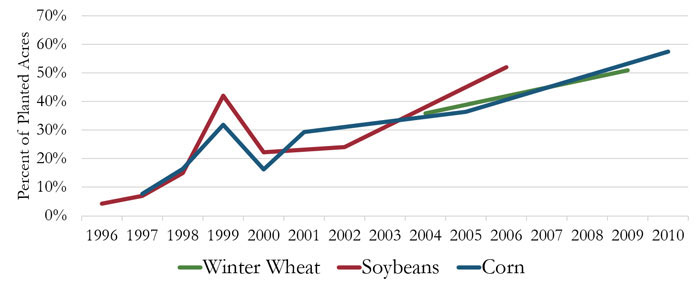Excerpted from the Environmental Impact of Missouri Crop Production report
- Farmer use of precision agricultural technology is increasing at different rates for different technologies, and adoption varies by farm size.
- Precision agriculture technologies help farmers reduce use of inputs such as fuel and fertilizer.
Farmers can use precision agriculture technology to fine-tune their production practices and gain detailed in-field information. This information can be used to decrease input costs, increase yields and potentially reduce a farm’s environmental impact. Precision agriculture tools include yield monitors, control systems, sensors, drones, guidance and auto-steering systems, GPS-based soil sampling and variable-rate technology (VRT).
In the U.S., adoption rates of precision agriculture vary significantly across technologies. Overall adoption rates of precision agriculture practices are lower in Missouri than the U.S. as a whole. The graph below shows the trends in precision agriculture adoption between 1996 and 2010. This shows the percentage of acres that have adopted any type of precision agriculture technology.
Adoption rates of precision agriculture technologies in Missouri, 1996–2010

Source: USDA Agricultural Resource Management Survey (2017)
Precision agriculture technologies increase the efficiency of agricultural inputs so fewer inputs are “wasted.” Although quantifiable results were not available, several research articles have noted the ability of precision agriculture technologies to enhance environmental conditions. Guidance systems save money and reduce chemical and fuel use by better aligning the seeding of field crop rows and reducing overapplication and underapplication of sprays. VRT can be used to apply fertilizer and pesticides at different rates throughout a field. Better placement should keep more of the fertilizer and pesticides on their intended target and out of waters. It can also assist in accurately observing and recording nutrient management plan compliance.
The table below highlights Missouri adoption of several precision agriculture technologies.
| Corn (2010) | Cotton (2007) | Rice (2006) | Sorghum (2003) | Soybeans (2006) | Winter Wheat (2009) | |
|---|---|---|---|---|---|---|
| Yield monitor | 48% | 6%* | 53% | 33% | 45% | 45% |
| Yield map created | 16% | NA | 10% | 11% | 15% | 8% |
| GPS device used to create soil properties map | 5% | NA | NA | 14% | 8% | 3% |
| Guidance or auto-steering system used | 35% | NA | NA | 12% | NA | NA |
| VRT used for any purpose | 1% | NA | NA | 7% | 6% | 7% |
| * Statistically unreliable due to a low sample size. NA: Estimate does not comply with NASS disclosure practices, is not available or is not applicable. Source: USDA Agricultural Resource Management Survey (2017) | ||||||